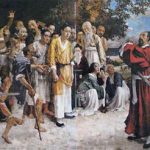Also known as the ‘Indian Army’, this was a British – officered military force in India; the other ranks, corporals, sergeants and warrant officers were recruited from the native population. Even so, some purely European regiments managed to stay put until the early 1860s.
The Indian Army served outside India as well, and had a deserved reputation for ferocity and good discipline; it remained (at least until the Sepoy Rebellion) a staunch and integral part of the Pax Britannica. It creators were locally found guards employed in the protection of the East India Company, known as sepoys.
In 1748 the increasing French influence in Madras, plus the continuous bad relation between France and Britain in Europe and the rest of the world, made the Company a permanent force in India. The armies of Bengal, Bombay and Madras matured independently until 1759, when numbers, administration and organization of all units were standardized. By 1796 every regiment contained two battalions (almost the same as in Great Britain herself). Except for the officers, every regiment was Indian; Bengal had twelve, Madras eleven and Bombay six. Bengal and Madras had the advantage of having cavalry regiments, though it must be said that the latter seemed more like privately-raised elite bodies belonging to gung-ho Company officials.
The sometimes under-regulated growth of this sprawling force was a reflection of the Company’s increased territorial acquisitions, and a take-over of what had previously been Mughal administrations. It might have been enormous, but it was inefficient and apparently amateur. Defects and rifts appeared, especially between members of the exclusively white European officers. Then came the extremely bloody and fierce Indian Mutiny of 1857 and 1858. The East India Company was blamed for this insurrection, and dissolved, and the Indian Army became the property of the Crown. In 1861 most regiments had become parts of the British Army and were ruled from Britain.
The guarding of the great North – West Frontier (including Afghanistan) became the chief responsibility of the Indian Army and remained so between 1858 and 1914. By 1903 Lord Kitchener (q.v.) had administratively combined Staff and Troops into one British Indian Army. During the Great War the performance, courage and endeavour of the Indian Army, and the rapidly changing political climate encouraged the authorities to include Indians as eligible for officer status.
By 1924 there were eight entirely Indian units and in 1934 an Indian military academy was founded (at Dehra Dun) for the training of officers. In The Second World War the reliable force of the Indian Army was used by Britain throughout the world, though its main part was much in evidence in Burma, now Myanmar. An end comes for everything, however, and when India became independent in 1947, the British Indian Army ceased to exist as such, its immense resources being deployed between India and the newly created state of Pakistan, where British Army training methods and typical officer/men relations remain to this day.










Leave A Comment